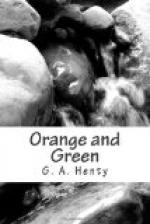Inside the town, the articles of the treaty were at once violated. The troops entered the town in crowds, and, incited, as in Dublin, by a mob calling themselves Protestants, they proceeded to plunder the houses and assault the Catholic inhabitants. The governor, M’Carty, was wounded. The Earls of Tyrone and Clancarty, with difficulty, made their escape from the mob. Many were killed, and a great destruction of property took place, before Marlborough and Wirtemberg entered the town and put a stop to the disorder, which inflicted great discredit upon them, as they had made no arrangements, whatever, to ensure the safety of the inhabitants, which they had solemnly guaranteed.
It was now October, and Marlborough at once set about the investment of Kinsale. On the very evening of the day he entered Cork, he sent off five hundred horse towards that town, and the next day marched thither himself at the head of his infantry. The works of Kinsale consisted of two forts, both of considerable strength, called the Old Fort and Charles’s Fort. They were well supplied with stores and provisions for a siege. On the approach of the besiegers, the governor set fire to the town and retired to the forts, and, in answer to the summons to surrender, replied that “it would be time enough to talk about that a month hence.”
Marlborough ordered General Tettau to cross the river in boats, with eight hundred picked men, and to carry Old Fort by storm. The assault was made with great determination and bravery; but the works were strong and stoutly defended, and the British were about to fall back, discomfited, when fortune came to their assistance. Some loose powder ignited and fired the magazine, by which more than two hundred men of the garrison were killed, and the works seriously injured. After this disaster, the governor abandoned the fort and withdrew, with the survivors of its garrison, to Charles’s Fort. Marlborough at once commenced the siege of this position, but for fifteen days the place resisted all his efforts. The heavy loss, however, which the garrison had suffered by the explosion in Old Fort, rendered them unable, by sallies, to interfere with the works of the besiegers. These were carried on with great vigour, for Marlborough feared that the approach of the wet season would put a stop to his operations.
When, therefore, the governor offered to surrender, on the terms of his being permitted “to march away with his garrison, their arms, baggage, and all the honours of war, taking with them all persons who wished to accompany them, together with their property, to Limerick,” Marlborough at once granted the terms demanded.
The advent of winter now put a stop to regular operations; but a war of skirmishes continued, and the British, in their quarters, were greatly straitened for forage and provisions. In Dublin, the work of confiscation went on merrily. The greater part of the Catholic proprietors of the town were thrown into prison. The various indictments against country gentlemen, followed by the confiscation of their property, were hurried through the court with the merest shadow of legal form; for, the defendants being absent and unacquainted with what was being done in Dublin, it was only necessary to recite the accusation to find the accused guilty, and to pass sentence of confiscation—all this being the work of a few minutes only.




